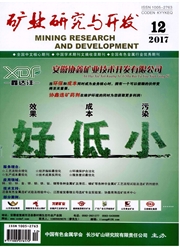

 中文摘要:
中文摘要:
基于生态场理论和GIS技术研究矿区土地资源的采动效应。首先介绍了采动土壤特性测算、采动变化规律分析及土壤采动损害评价的程序方法;然后叙述了采用RS和GIS空间分析技术对土地资源各采动生态位指标进行量化。并基于生态场理论和开采沉陷学分析土地资源的采动空间分异特征、采动累积效应及其延迟效应的过程。对山西潞安集团五阳矿井采煤沉陷区的实例分析表明,耕地土壤特性与开采沉陷明显相关,1997年至2002年间采动生态元耕地和植被覆盖率上升而建设用地覆盖率下降,研究区土壤侵蚀以轻度和中度为主且明显存在采动延迟,土地利用集约度指数终采后10a逐步进入稳定期,各地类的流失与来源组成趋于稳定,说明土地利用方式摆脱采动影响并进入新的动态平衡状态。
 英文摘要:
英文摘要:
The mining- induced effect on land resource in Mining was researched based on ecological field theory and GIS technology. In the paper, the methods to test and calculate the characteristics of mining soil, to analyze the mining - induced changing law of soil and to evaluate mining - induced soil damage are introduced. Then, the procedures are related, such as quantizing mining - induced niche indices of soil with the RS and GIS space analysis methods, by the theory of ecological field and mining subsidence analyzing the mining - induced spatial differentiation characteristics of soil, mining - induced cumulative effect and late effect on land resource. The mining subsidence areas in Wuyang Mine of Lu'an Coal Mining Group, Shanxi province,as the case are analyzed. The results of the case study show that the obvious space - related law exists between the characteristics of arable soil and mining subsidence. During 1997 to 2002,the mininginduced land ecounit used for building was generally decreasing, while that used for farmland and the vegetation was increasing, in the investigated areas the soil erosion intensity was mainly light or medium, and the soil erosion obviously lagged behind the mining activity. The land using intensity index will reach the steady level in the ten years after ending mining activity. The stabilized trend will occur between the loss and source of various land - use types. The patterns of land use will return to a new dynamic equilibrium state, shruging off the effect of mining.
 同期刊论文项目
同期刊论文项目
 同项目期刊论文
同项目期刊论文
 期刊信息
期刊信息
